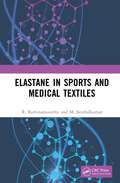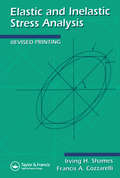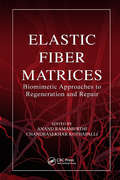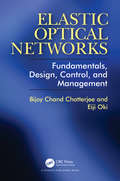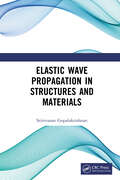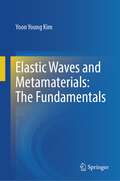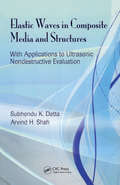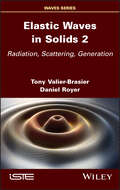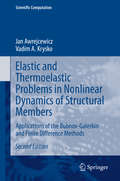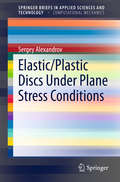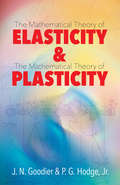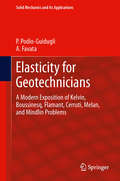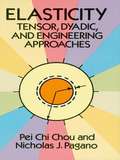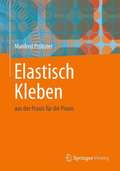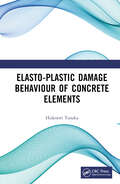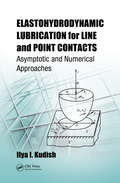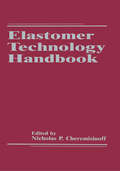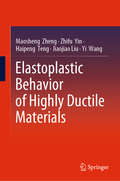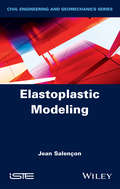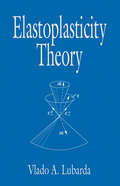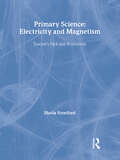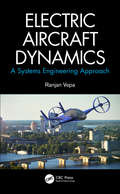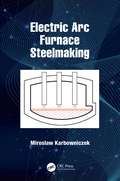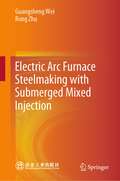- Table View
- List View
Elastane in Sports and Medical Textiles
by R. Rathinamoorthy M. SenthilkumarElastic garments have tremendous scope in the field of tight-fit sportswear and healthcare applications. Research towards improvement in the elasticity of fibre, yarn, and fabrics and development in testing methods for elastic garments is the current requirement for the industrial product development. This book covers elastane fibres, elastane yarn and fabric production methods, new attempts in yarn production, commercial ways of fabric-manufacturing techniques and the fabric properties, new testing methods to test the elastic products, and applications of elastic garments in sports and healthcare. Features: Provides comprehensive review, process, and application of elastane fibres. Covers detailed information about manufacturing and testing methods of elastane fabrics. Reviews technical aspects of elastane in sportswear and healthcare. Discusses evaluation process for the elastane fabric performance. Defines production methods of woven and knitted fabrics using elastane. This book is aimed at students and researchers in textile engineering/technology, textile design, human ecology and comfort, material engineering, sports sciences, medical science, and healthcare engineering.
Elastic And Inelastic Stress Analysis
by Irving H ShamesPresents certain key aspects of inelastic solid mechanics centered around viscoelasticity, creep, viscoplasticity, and plasticity. It is divided into three parts consisting of the fundamentals of elasticity, useful constitutive laws, and applications to simple structural members, providing extended treatment of basic problems in static structural m
Elastic Fiber Matrices: Biomimetic Approaches to Regeneration and Repair
by Anand Ramamurthi and Chandrasekhar KothapalliElastic Fiber Matrices: Biomimetic Approaches to Regeneration and Repair provides a comprehensive resource on the intrinsic and pathological aberrations of the complex process of elastic matrix assembly and/or variations thereof in different elastic tissue types, and on strategies to regenerate or restore lost elastin matrix, either in vitro or in vivo, including biomimetic elastin-like-peptides, gene therapy, drug delivery, tissue engineering (biomolecules, scaffolds, and mechanical stimuli), pharmacological approaches, elastin stabilization and preservation, stem cell therapy, allografts/xenografts, and synthetic/biological elastomers. Comprised of individual chapters contributed by leading researchers and scientists in the field, the text details current approaches for elastin matrix regeneration and repair, identifying their various advantages and limitations while offering valuable insight into emerging trends. Thus, this book is a must-have guide for academicians and industry professionals working in the areas of connective tissue biology, tissue engineering, dermal and cardiovascular biomaterials, and drug delivery.
Elastic Optical Networks: Fundamentals, Design, Control, and Management
by Eiji Oki Bijoy ChatterjeeThe rapid growth in communications and internet has changed our way of life, and our requirement for communication bandwidth. Optical networks can enable us to meet the continued demands for this bandwidth, although conventional optical networks struggle in achieving this, due to the limitation of the electrical bandwidth barrier. Flexgrid technology is a promising solution for future high-speed network design. To promote an efficient and scalable implementation of elastic optical technology in the telecommunications infrastructure, many challenging issues related to routing and spectrum allocation (RSA), resource utilization, fault management and quality of service provisioning must be addressed. This book reviews the development of elastic optical networks (EONs), and addresses RSA problems with spectrum fragment issues, which degrade the quality of service provisioning. The book starts with a brief introduction to optical fiber transmission system, and then provides an overview of the wavelength division multiplexing (WDM), and WDM optical networks. It discusses the limitations of conventional WDM optical networks, and discusses how EONs overcome these limitations. It presents the architecture of the EONs and its operation principle. To complete the discussion of network architecture, this book focuses on the different node architectures, and compares their performance in terms of scalability and flexibility. It reviews and classifies different RSA approaches, including their pros and cons. It focuses on different aspects related to RSA. The spectrum fragmentation is a serious issue in EONs, which needs to be managed. The book explains the fragmentation problem in EONs, discusses, and analyzes the major conventional spectrum allocation policies in terms of the fragmentation effect in a network. The taxonomies of the fragmentation management approaches are presented along with different node architectures. State-of-the-art fragmentation management approaches are looked at. A useful feature of this book is that it provides mathematical modeling and analyzes theoretical computational complexity for different problems in elastic optical networks. Finally, this book addresses the research challenges and open issues in EONs and provides future directions for future research.
Elastic Wave Propagation in Structures and Materials
by Srinivasan GopalakrishnanElastic Wave Propagation in Structures and Materials initiates with a brief introduction to wave propagation, different wave equations, integral transforms including fundamentals of Fourier Transform, Wavelet Transform, Laplace Transform and their numerical implementation. Concept of spectral analysis and procedure to compute the wave parameters, wave propagation in 1-D isotropic waveguides, wave dispersion in 2-D waveguides is explained. Wave propagation in different media such as laminated composites, functionally graded structures, granular soils including non-local elasticity models is addressed. The entire book is written in modular form and analysis is performed in frequency domain. Features: Brings out idea of wave dispersion and its utility in the dynamic responses. Introduces concepts as Negative Group Speeds, Einstein’s Causality and escape frequencies using solid mathematical framework. Discusses the propagation of waves in materials such as laminated composites and functionally graded materials. Proposes spectral finite element as analysis tool for wave propagation. Each concept/chapter supported by homework problems and MATLAB/FORTRAN codes. This book aims at Senior Undergraduates and Advanced Graduates in all streams of engineering especially Mechanical and Aerospace Engineering.
Elastic Waves and Metamaterials: The Fundamentals
by Yoon Young KimThis book serves as an introductory text for students and engineers with limited knowledge of metamaterials (and elastic waves). This text begins with the most straightforward vibrating systems, such as single and 2-DOF spring-mass systems. It examines the observed phenomena in 2-DOF systems in an unconventional manner to prepare the reader for research on metamaterials. After presenting wave phenomena in an infinitely connected spring-mass system, an elastic bar, a continuous version of an infinite system, is analyzed. This instructional strategy, which progresses from the discrete model to the continuous model, facilitates efficient comprehension of wave and metamaterial concepts. Using continuous and discrete one-dimensional models, bending waves and their manipulation through metamaterials are also discussed. In the latter chapters of this book, advanced readers are introduced to the fundamental wave phenomena in two-dimensional media and wave manipulation using metamaterials, such as mode-converting transmission. As wave phenomena are the fundamental phenomena in vibrating structures, those interested in acoustics and vibration would gain a great deal of knowledge from this book, as the material covered in it offers a very different perspective on oscillatory phenomena than what is typically found in books on acoustics and vibration. Because this book presents a new technique for manipulating waves using metamaterials, engineers and scientists who work with (ultra)sounds and structural vibrations would find it very useful for expanding their knowledge of relevant topics.
Elastic Waves in Composite Media and Structures: With Applications to Ultrasonic Nondestructive Evaluation (Mechanical and Aerospace Engineering Series)
by Subhendu K. DattaNew applications for composite materials are being developed at a rapid pace. However, their complex microstructures present considerable challenges for nondestructive testing and characterization. Ultrasonic waves provide quantitative means of nondestructive evaluation of these materials and structures. For this purpose, it is necessary to obtain
Elastic Waves in Solids, Volume 2: Radiation, Scattering, Generation
by Daniel Royer Tony Valier-BrasierElastic waves are used in fields as diverse as the non-destructive evaluation of materials, medicine, seismology and telecommunications. Elastic Waves in Solids 2 analyzes the radiation, scattering and generation of these waves. It studies the emission of bulk or surface waves from sources localized on the surface of an isotropic or anisotropic solid. It then examines the scattering of a longitudinal or transverse elastic wave by one or more cylindrical or spherical heterogeneities. Finally, it explores the methods and devices used to generate and detect elastic waves, using the piezoelectric effect or the interaction with a laser beam. Accompanying figures illustrate these properties, and the text provides the orders of magnitude of some characteristic parameters. This book is intended for students completing a master&’s degree in acoustics, mechanics, geophysics or engineering, as well as teachers and researchers in these disciplines.
Elastic and Thermoelastic Problems in Nonlinear Dynamics of Structural Members: Applications of the Bubnov-Galerkin and Finite Difference Methods (Scientific Computation)
by Jan Awrejcewicz Vadim A. KryskoFrom the reviews: "A unique feature of this book is the nice blend of engineering vividness and mathematical rigour. [...] The authors are to be congratulated for their valuable contribution to the literature in the area of theoretical thermoelasticity and vibration of plates." Journal of Sound and Vibration
Elastic/Plastic Discs Under Plane Stress Conditions
by Sergey AlexandrovThis Volume presents a unified approach to calculate the plane stress distribution of stress and strain in thin elastic/plastic discs subject to various loading conditions. There is a vast amount of literature on analytical and semi-analytical solutions for such discs obeying Tresca's yield criterion and its associated flow rule. On the other hand, most of analytical and semi-analytical solutions for Mises yield criterion are based on the deformation theory of plasticity. A distinguished feature of the solutions given in the present volume is that the flow theory of plasticity and Mises yield criterion are adopted. The solutions are semi-analytical in the sense that numerical methods are only necessary to evaluate ordinary integrals and solve transcendental equations. The book shows that under certain conditions solutions based on the deformation and flow theories of plasticity coincide. All the solutions are illustrated with numerical examples. The goal of the book is to provide the reader with a vision and an insight into the problems of analysis and design of elastic/plastic discs. The limitations and the applicability of solutions are emphasized. The book is written for engineers, graduate students and researchers interested in the development of techniques for analysis and design of thin elastic/plastic discs.
Elasticity and Plasticity: The Mathematical Theory of Elasticity and The Mathematical Theory of Plasticity (Dover Books on Mathematics)
by J. N. Goodier P. G. Hodge Jr.This volume comprises two classic essays on the mathematical theories of elasticity and plasticity by authorities in this area of engineering science. Undergraduate and graduate students in engineering as well as professional engineers will find these works excellent texts and references. The Mathematical Theory of Elasticity covers plane stress and plane strain in the isotropic medium, holes and fillets of assignable shapes, approximate conformal mapping, reinforcement of holes, mixed boundary value problems, the third fundamental problem in two dimensions, eigensolutions for plane and axisymmetric states, anisotropic elasticity, thermal stress, elastic waves induced by thermal shock, three-dimensional contact problems, wave propagation, traveling loads and sources of disturbance, diffraction, and pulse propagation. The Mathematical Theory of Plasticity explores the theory of perfectly plastic solids, the theory of strain-hardening plastic solids, piecewise linear plasticity, minimum principles of plasticity, bending of a circular plate, and other problems.
Elasticity for Geotechnicians
by Paolo Podio-Guidugli Antonino FavataThis book deals in a modern manner with a family of named problems from an old and mature subject, classical elasticity. These problems are formulated over either a half or the whole of a linearly elastic and isotropic two- or three-dimensional space, subject to loads concentrated at points or lines. The discussion of each problem begins with a careful examination of the prevailing symmetries, and proceeds with inverting the canonical order, in that it moves from a search for balanced stress fields to the associated strain and displacement fields. The book, although slim, is fairly well self-contained; the only prerequisite is a reasonable familiarity with linear algebra (in particular, manipulation of vectors and tensors) and with the usual differential operators of mathematical physics (gradient, divergence, curl, and Laplacian); the few nonstandard notions are introduced with care. Support material for all parts of the book is found in the final Appendix.
Elasticity: Tensor, Dyadic, and Engineering Approaches (Dover Civil and Mechanical Engineering)
by Nicholas J. Pagano Pei Chi ChouExceptionally clear text treats elasticity from engineering and mathematical viewpoints. Comprehensive coverage of stress, strain, equilibrium, compatibility, Hooke's law, plane problems, torsion, energy, stress functions, more. 114 illustrations. 1967 edition.
Elastisch Kleben: aus der Praxis für die Praxis
by Manfred PröbsterEine Einführung in das Elastische Kleben für den Praktiker. Neben den Grundlagen werden Kenntnisse der wichtigsten Gruppen der elastischen Klebstoffe dargestellt. Der Schwerpunkt des Fachbuchs liegt auf praktischen Hinweisen, die zu langzeitstabilen Klebungen führen und die der Fehlervermeidung dienen. Zahlreiche Anwendungen erfolgreicher elastischer Klebungen aus der Kfz-Technik, dem Fassaden- und Metallbau illustrieren das Konzept.
Elastisch Kleben: aus der Praxis für die Praxis
by Manfred PröbsterEine Einführung in das Elastische Kleben für den Praktiker. Neben den Grundlagen werden Kenntnisse der wichtigsten Gruppen der elastischen Klebstoffe dargestellt. Der Schwerpunkt des Fachbuchs liegt auf praktischen Hinweisen, die zu langzeitstabilen Klebungen führen und die der Fehlervermeidung dienen. Zahlreiche Anwendungen erfolgreicher elastischer Klebungen aus der Kfz-Technik, dem Fassaden- und Metallbau illustrieren das Konzept.
Elasto-Plastic Damage Behaviour of Concrete Elements
by Hidenori TanakaElasto-Plastic Damage Behaviour of Concrete Elements presents the results of practical experiments with numerical analyses and case studies, along with a summary of basic theory, to provide an accessible explanation for young practising engineers on the performance evaluation of concrete structures. It shows how the mechanical phenomena of familiar concrete structures can be expressed using mathematical models and provides a solid basic understanding of the nonlinear behaviour of concrete structures. It applies elasto-plastic theory to damage mechanics and the modelling of cracks in concrete, drawing on the author’s 25 years of design and construction experience as a professional engineer, as well as recent research. Sets out the reality of damage mechanics in concrete Connects standard theory with good design and construction practice The book is suitable for structural design engineers and researchers.
Elastohydrodynamic Lubrication for Line and Point Contacts: Asymptotic and Numerical Approaches
by Ilya I. KudishThis unique book presents a coherent asymptotic approach to the analysis of elastohydrodynamic lubrication (EHL) problems for heavily loaded line and point contacts. This approach leads to unified asymptotic equations for line and point contacts as well as stable numerical algorithms for the solution of these problems. Suitable for engineering and applied mathematics students, this is also a unique resource for researchers and practitioners who want to fine tune their solution methods and design better numerical methods to tackle practical EHL problems.
Elastomer Technology Handbook
by Nicholas P. Cheremisinoff Paul N. CheremisinoffElastomer Technology Handbook is a major new reference on the science and technology of engineered elastomers. This contributed volume features some of the latest work by international experts in polymer science and rubber technology. Topics covered include theoretical and practical information on characterizing rubbers, designing engineering elastomers for consumer and engineering applications, properties testing, chemical and physical property characterization, polymerization chemistry, rubber processing and fabrication methods, and rheological characterization. The book also highlights both conventional and emerging market applications for synthetic rubber products and emphasizes the latest technology advancements. Elastomer Technology Handbook is a "must have" book for polymer researchers and engineers. It will also benefit anyone involved in the handling, manufacturing, processing, and designing of synthetic rubbers.
Elastoplastic Behavior of Highly Ductile Materials
by Yi Wang Maosheng Zheng Zhifu Yin Haipeng Teng Jiaojiao LiuThis book mainly introduces some basic phenomena and laws of highly ductile materials during elastoplastic deformation, and their engineering applications, such as the transfer and relief of stress concentration in the notch root, the mitigation of possible brittle fracture, the ductile deformation and damage, fatigue, energy absorption, plastic buckling, thermal stress problems, etc. It shows a number of revolutions in modern applications and design, which are beneficial to the safety of modern equipment, and improve applicability. In addition, the first three chapters of this book also briefly introduce the basic knowledge of elastoplastic deformation and analysis as a preliminary knowledge. This book can be used as a textbook for advanced undergraduate students and postgraduate in non-mechanics majors such as mechanical engineering, power, material or civil engineering, as well as scholars and engineers in related fields.
Elastoplastic Modeling
by Jean SalenconElastoplastic behavior has long been part of the constitutive models incorporated in most computer codes, used in the design of civil and mechanical engineering structures. Elastoplastic Modeling offers a compact presentation of the fundamentals of classical elastoplastic modeling, the basis for many engineering applications currently implemented. This book provides a general background to enhance understanding of the modeling assumptions that govern the rationales of these applications. With this understanding comes the ability to assess their validation range and propose possible improvements. An instructive approach replaces excessive mathematical developments with a semi-phenomenological method, where mathematical modeling is driven by − and derived from − experimental observations. A logical track is followed, starting from material behavior modeling and leading to the analysis of the anelastic response of systems, subjected to quasi-static loading processes.
Elastoplasticity Theory
by Vlado A. LubardaUnderstanding the elastoplastic deformation of metals and geomaterials, including the constitutive description of the materials and analysis of structure undergoing plastic deformation, is an essential part of the background required by mechanical, civil, and geotechnical engineers as well as materials scientists. However, most books address the su
Elect&Mag Prim Sci: Teacher's Cd-rom Pack For Key Stages 1 And 2
by Fabienne Brochier Mike Diprose Nabeel Nasser Sheila StratfordFirst published in 2004. Routledge is an imprint of Taylor & Francis, an informa company.
Electric Aircraft Dynamics: A Systems Engineering Approach
by Ranjan VepaElectric Aircraft Dynamics: A Systems Engineering Approach surveys engineering sciences that underpin the dynamics, control, monitoring, and design of electric propulsion systems for aircraft. It is structured to appeal to readers with a science and engineering background and is modular in format. The closely linked chapters present descriptive material and relevant mathematical modeling techniques. Taken as a whole, this groundbreaking text equips professional and student readers with a solid foundation for advanced work in this emerging field. Key Features: Provides the first systems-based overview of this emerging aerospace technology Surveys low-weight battery technologies and their use in electric aircraft propulsion Explores the design and use of plasma actuation for boundary layer and flow control Considers the integrated design of electric motor-driven propellers Includes PowerPoint slides for instructors using the text for classes Dr. Ranjan Vepa earned his PhD in applied mechanics from Stanford University, California. He currently serves as a lecturer in the School of Engineering and Material Science, Queen Mary University of London, where he has also been the programme director of the Avionics Programme since 2001. Dr. Vepa is a member of the Royal Aeronautical Society, London; the Institution of Electrical and Electronic Engineers (IEEE), New York; a Fellow of the Higher Education Academy; a member of the Royal Institute of Navigation, London; and a chartered engineer.
Electric Arc Furnace Steelmaking
by Miroslaw KarbowniczekThe importance of electric arc furnace steelmaking is evident from the escalated world production seen in steel industry. This book presents systematic and complete details on the current state of knowledge about metallurgical processes carried out in the electric arc furnace. It includes principles of construction of electric arc furnaces, applied construction solutions, and their operations (together with auxiliary/supportive devices). Modern technologies of melting of various grades steel are detailed, considering the participation of secondary metallurgy including theoretical backgrounds of chemical processes and reactions. It contains theoretical analysis and results of laboratory, model, and industrial tests. Features: Covers the practical aspects of electric arc furnace steelmaking including technological process. Discusses the operation issues of an electric arc furnace in a technical and technological context. Presents a systematic and complete knowledge about relevant construction solutions and metallurgical processes. Includes practical industrial benchmark indicators in the scope of equipment and technology. Analyses practical case studies from industry. This book aims at researchers, professionals and graduate students in Metallurgical Engineering, Materials Science, Electric Power Supply, Environmental Engineering, and Mechanical Engineering.
Electric Arc Furnace Steelmaking with Submerged Mixed Injection
by Rong Zhu Guangsheng WeiThis book focuses on the study of electric arc furnace (EAF) steelmaking with submerged injection. The new EAF process with submerged mixed injection was first proposed and applied by the authors. It analyzes the mechanism of submerged O2-CaO and carbon powder injection, the impact characteristics of submerged gas-solid injection and the fluid flow characteristics of EAF molten bath with submerged gas-solid injection. The industrial application of EAF steelmaking with submerged gas-solid injection was introduced. Finally, the book reviews the recent innovations and advances of injection metallurgy in EAF steelmaking. It also proposes a possible future process for cyclic utilization of CO2 in EAF-LF steelmaking process. This book provides basic data support for the industrial application of EAF steelmaking with submerged mixed injection for researchers, engineering and technical personnel and industrial professionals.
